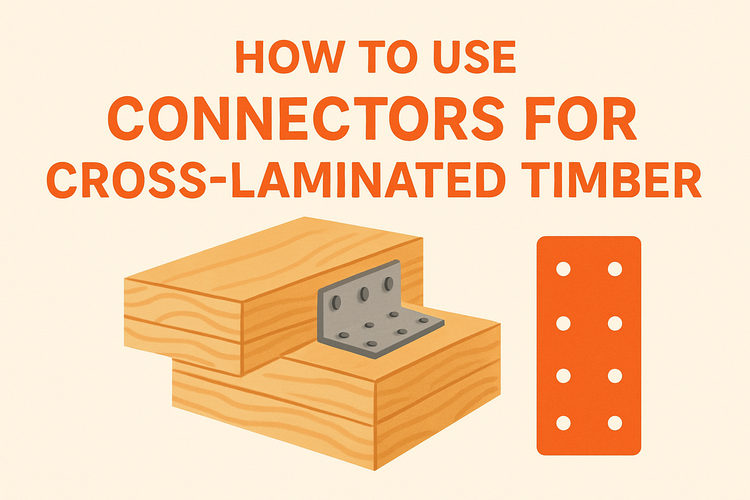How To Use Connectors For Cross Laminated Timber

Understanding Connectors for Cross Laminated Timber (CLT)
Connectors for Cross Laminated Timber (CLT) are crucial components in timber construction. They ensure structural integrity and enable the secure assembly of panels and elements.
CLT connectors come in many forms and are used at various joints—walls to floors, wall intersections, and roof connections. Choosing the correct connector is essential for durability, load-bearing capacity, and compliance with safety regulations. By understanding the different types of connectors, you can maximize the performance of your CLT structures.
Types of Connectors Used in CLT Applications
There are a variety of connectors designed specifically for different CLT joint conditions. These include angle brackets, joist hangers, and restraint straps, among others, each serving a unique function.
Angle brackets are commonly used for corner joints and to tie panels together, providing lateral stability. Joist hangers are essential when fixing floor panels or beams to CLT walls. These connectors must be selected based on load requirements and configuration of the structure.
Additionally, restraint straps are employed to resist uplift forces and lateral movements during high wind conditions or seismic activity. For more advanced requirements, specialized seismic brackets and heavy-duty connectors ensure strength and flexibility in demanding environments. Each of these components is tested and rated according to international structural standards.
Whether you're designing residential buildings or commercial structures, proper connector selection enhances the safety and lifespan of your CLT project. Always consult engineering guidelines and supplier specifications when integrating connectors into your build.
Installation Best Practices for CLT Connectors
Ensuring proper installation of CLT connectors provides long-term durability and adherence to design specifications. Poor installation can compromise strength and render other components ineffective.
Begin by following the manufacturer's guidelines for placement, fastener types, and spacing. This ensures the connectors perform as tested. For example, most connectors require specific screw or nail lengths and diameters—often found in dedicated product pages like those for CLT connectors.
Pre-drilling holes, especially in denser timber or in heavy-duty connectors, may be necessary to avoid timber splitting. It's also important to ensure the CLT panels are clean and flat at the points of contact before installation. Any misalignment during mounting can reduce the connector’s load-bearing capacity and lead to long-term issues like warping or joint separation.
During installation, attention must also be given to sequencing. Some connectors need to be installed before panel placement, while others can be added post-installation. Review job-site workflows to avoid costly rework or missed anchoring points.
Structural Considerations for CLT Connections
Connection design is more than simply joining two elements. It plays a vital role in how a building handles gravity, wind, earthquakes, and even moisture.
Engineers consider loads, tension zones, compression areas, and shear forces when selecting and positioning connectors. For instance, the choice between nailed plate connectors or hidden fasteners can affect the building’s aesthetic and structural performance. Heavier structures or taller buildings may require addition of high wind ties & timber connectors for added safety.
Moisture control also needs to be factored in. Improperly protected connectors may corrode, especially in exterior applications or humid climates. Galvanized or stainless steel variants are often recommended in these settings. Where aesthetics matter, hidden connectors ensure clean junction detailing without compromising integrity.
Furthermore, CLT buildings often rely on diaphragm action for distributing lateral loads, which means connectors must be capable of transferring forces between panels. Inadequate design can result in failure under wind or seismic conditions. That’s why comprehensive engineering evaluation is crucial when designing and placing structural connectors.
Choosing the Right Connectors for Your CLT Project
Selecting suitable connectors depends on your project’s unique needs. From simple residential wall joints to large-scale commercial spans, each scenario demands specific solutions.
Post base connectors are critical where columns interface with concrete or ground-level foundations. These help in elevating the timber, preventing water wicking, and ensuring anchor load transfer. Meanwhile, wall-to-wall and wall-to-floor connections benefit from heavy-duty angle brackets and steel plates that can handle multidimensional loads.
Factors such as fire ratings, corrosion resistance, and movement accommodation (expansion/contraction) also guide the selection process. Sustainable sourcing and compliance with local building codes likewise play a role. Fortunately, the wide range of CLT connectors available offers flexibility and performance for nearly every design challenge.
It is beneficial to collaborate with product manufacturers and distributors who understand timber engineering. Whether sourcing connectors or getting advice on installation, reliable suppliers add long-term value to any CLT project and help safeguard your build against structural inconsistencies.
